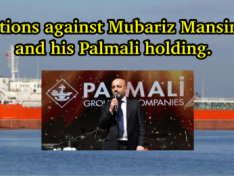
Minefields, unexploded ordnance and improvised explosive devices are considered the main problem of any post-conflict area. In addition to saving human lives, demining is aimed at promoting the development of a country's economy and agriculture, and improving the welfare of the population.
The world community turns a blind eye to the mining of the territories of Azerbaijan, while every day, people are killed and injured from mine explosions, according to the statement of non-governmental organizations working with the problem of mine danger in Azerbaijan.
Mine explosions regularly kill or injure both military personnel and civilians in the territories that came under the control of Azerbaijan after the 2020 Karabakh war. On September 30, Azerbaijani residents Amid Asadov and Charkaz Guluzade were fatally injured when they hit a mine in the Fuzuli district, the country's Prosecutor General's Office reported. On October 1, two residents of the Tartar district were blown up by a mine, their legs were amputated, and on October 2, a worker was injured during a mine explosion.
In a statement, NGO representatives accused the Armenians of continuing to mine the territories of Azerbaijan. "One of the reasons for the escalation on the Azerbaijani-Armenian border on September 12-13 is connected with this provocation. During the inspection of these territories, it was found that the Armenians again buried thousands of mines," says the statement.
The statement notes that the world community "turns a blind eye to the mining" of the territories of Azerbaijan and "remains silent."
"As civil society organizations, we are witnessing the neglect of international organizations and donors to the mine problem in our country. We appeal to the UN and its agencies, international organizations <...> and call on them to support the solution of the mine problem in Azerbaijan," human rights activists said.
In turn, the Azerbaijani Foreign Ministry stated that the mines laid by Armenia today pose a severe threat to the lives of people in the region.
"From November 2020 to the present day, up to 250 people, mostly civilians, have become victims of mines. The fact that the mines found on the territory of Azerbaijan were produced in Armenia in 2021 proves that Armenia continues its war crimes against Azerbaijanis, still not handing over maps of minefields to Azerbaijan, but on the other hand, burying new mines. The Government of Armenia has not yet taken any practical measures to prevent war crimes or hold relevant persons accountable for the crimes committed. We demand that Armenia fulfill its international obligations and bring to justice those guilty of numerous war crimes," the ministry said.
Faktyoxla Lab tried to find out how justified the statements of the Azerbaijani side are.
Let's start with the fact that Azerbaijan proposes to create a Global Trust Fund to Combat the Mine Threat. This was stated by the presidential aide - head of the foreign policy department of the presidential administration Hikmat Hajiyev.
"The mine problem is one of the most urgent for Azerbaijan. Today, the liberated lands of Azerbaijan are one of the most mine-contaminated territories in the world," said Hajiyev, speaking in Baku at the international conference "Humanitarian demining and sustainable development goals" in early April 2022.
That is, the problem for Azerbaijan is relevant in many areas.
The fact is that the Armenian side has widely used and, apparently, is using mining on the territory of Azerbaijan. The insidious properties of this weapon and the mass and indiscriminate effects of its use by the Armenians, should have earned them a bad reputation worldwide. But as we can see, this does not happen.
Secondly, the mine problem was first discussed at an international symposium in Montreux (Switzerland), convened on the International Committee of the Red Cross (ICRC) initiative on April 21-23, 1993. This symposium discussed various aspects of using mines, primarily anti-personnel mines, as they are the most dangerous for the civilian population. The next symposium, convened in Geneva on 10-12 January 1994, again at the initiative of the ICRC, focused on the military issue of using anti-personnel mines (APMs), measures to control their use, as well as alternative systems that could replace APMs. The goal was to develop common views of international experts on the mine problem and prepare materials for the February 1994 meeting of the working group to revise the 1980 Geneva Convention. International experts paid particular attention to the humanitarian aspect of the mine problem during these two symposiums.
The humanitarian component of the mine problem lies in the fact that the laid mines not only hit combatants directly on the battlefield but also pose a significant threat to the civilian population.
Numerous losses of the civilian population due to mines, especially the APMs, grave injuries and suffering of millions of adults and especially children, the limited ability of the international community to provide them with the necessary assistance and to clear mines, contrast the military aspects of the mine problem with its humanitarian component, the importance of which is confirmed by two international legal documents.
– the 1980 Geneva Convention with its Protocol II (as amended on May 3, 1996) and Protocol V on Explosive Remnants of War – 2003;
– The Ottawa Treaty (1997), to which the "Convention on the Prohibition of the Use, Stockpiling, Production and Transfer of APMs and on Their Destruction" was added (later called the 1997 Ottawa Convention).
Although more than 160 states adopted the Ottawa Convention, it is not universal, since the main countries that produce mines and possess their stocks (USA, Russia, China, India, Pakistan, Israel, etc.) have not joined it. By the way, out of 192 member countries of the United Nations, Armenia and Azerbaijan are among the 33 countries that have not signed or joined the Ottawa Convention, which entered into force in 1999.
And the adoption of Protocol II with amendments on May 3, 1996, in Geneva, did not lead to the resolution of the mine problem, although it was a very important and timely step in this direction. The delegations of many states were satisfied with the results of the negotiations and the adopted documents. Unfortunately, several Western and developing countries expressed dissatisfaction with Protocol II. The then UN Secretary-General Boutros Boutros-Ghali also expressed his dissatisfaction with the results.
In his message to the participants of the Conference, he noted that the revised Protocol did not fully reflect the interests of the international community. "He is disappointing us. We have not agreed on the mechanisms of verification, on the prohibition of the supply of mines. Speaking of "smart" mines, we forget that they are all inhumane. As a summary: "all mines must be eliminated now." But since then nothing has been done in reality and the problem remains.
Thirdly, Armenia handed over a map of minefields to Azerbaijan. But a preliminary acquaintance gives grounds to assert that the minefield maps handed over by the Armenian side to Baku are not accurate, they do not inspire confidence. ANAMA noted that usually the form of a mined area includes its coordinates, types of mines used, their number, information on the placement and masking of mines. However, the submitted forms, after preliminary examination, proved to be unsuitable and inaccurate.
But the fact is that the transfer of maps of minefields in Karabakh and East Zangazur to Azerbaijan was not a humanitarian gesture on the part of Armenia, but its international obligation after signing a tripartite statement in November 2020.
According to spokesperson of the Ministry of Foreign Affairs of Azerbaijan, Leyla Abdullayeva, after the liberation of its lands and after the signing of a tripartite statement (of the leaders of Azerbaijan, Armenia, Russia dated November 10, 2020), Azerbaijan raised the issue of the need to put pressure on Yerevan in order to provide Baku with maps of minefields, the Armenian side at first generally denied the existence of such maps.
She noted that then, faced with the position of the international community on this issue, Armenia provided Azerbaijan with maps of minefields in parts, but their accuracy was only 25%. “In general, it is wrong to present the transfer of mine maps by Armenia as a humanitarian gesture, since this was Armenia's international obligation after the signing of the tripartite statement,” Abdullayeva stressed.
So why does Armenia refuse to provide minefield maps? After all, this is what international laws and agreements on the cessation of hostilities require.
At first, it was said in Yerevan that during the entire period of the conflict, the Azerbaijani side had never come up with proposals for cooperation in demining issues. In addition, they stated that by demanding to provide maps of minefields, Azerbaijan allegedly puts forward a false agenda in order to divert the attention of the world community from other existing problems.
But, among the dead and wounded, there are mostly civilians trying to establish their life in their native places, the military of the Azerbaijani army, mine clearing sappers, Russian peacekeepers and Armenians living in Karabakh. The deadly danger that lurks in the earth threatens everyone equally. This is a real, huge, bleeding problem. Armenia must take into account that the refusal to hand over maps of minefields is a violation of international conventions and international law, and according to the norms of international law, Azerbaijan can demand from Armenia not only to issue maps of minefields, but then also demand payment for all demining works on the liberated territories. In addition, relatives of people killed and affected by mines can file claims in international courts demanding compensation.
But what if Armenia does not have maps of minefields? It is hard to believe in this version, since the Armenian military, laying mines, were not going to leave anywhere. And, therefore, they had to have maps of minefields, at least in order not to blow themselves up on them. On the other hand, the common practice when creating minefields is to make and keep one copy of the map in the unit located directly on the mined area, and transfer copies to higher headquarters. So those maps do exist.
Providing a map of minefields is a major humanitarian task, the implementation of which will save dozens, and perhaps hundreds of lives and crippled destinies. It will not only ensure the safety of civilians, but also open the way to regional development and cooperation, to the restoration of economic ties. But so far they do not understand or do not want to understand this in Armenia.




















